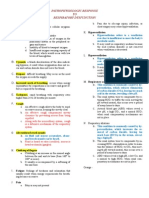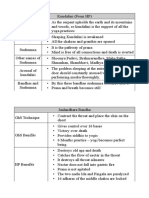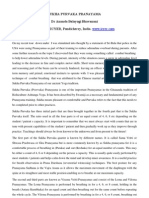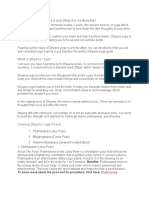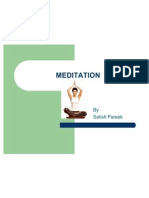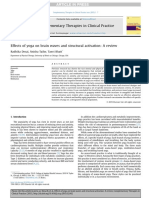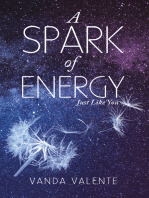0 ratings0% found this document useful (0 votes)
73 viewsVictory Breath Ujjayi Pranayama
Victory Breath Ujjayi Pranayama
Uploaded by
Sebastian StarkThis document describes several pranayama breathing exercises, including:
1) Three-part breath which involves breathing into three areas of the abdomen in a continuous and controlled manner.
2) Victory breath where the breath is made to sound like the ocean by contracting the throat on inhalation and exhalation.
3) Alternate nostril breathing that involves alternating inhalation and exhalation between the nostrils to balance the body.
4) Shining skull breath that is an invigorating breath involving forceful exhalation and passive inhalation to purify the body.
Copyright:
© All Rights Reserved
Available Formats
Download as PDF, TXT or read online from Scribd
Victory Breath Ujjayi Pranayama
Victory Breath Ujjayi Pranayama
Uploaded by
Sebastian Stark0 ratings0% found this document useful (0 votes)
73 views1 pageThis document describes several pranayama breathing exercises, including:
1) Three-part breath which involves breathing into three areas of the abdomen in a continuous and controlled manner.
2) Victory breath where the breath is made to sound like the ocean by contracting the throat on inhalation and exhalation.
3) Alternate nostril breathing that involves alternating inhalation and exhalation between the nostrils to balance the body.
4) Shining skull breath that is an invigorating breath involving forceful exhalation and passive inhalation to purify the body.
Original Title
Pranayama Exercises
Copyright
© © All Rights Reserved
Available Formats
PDF, TXT or read online from Scribd
Share this document
Did you find this document useful?
Is this content inappropriate?
This document describes several pranayama breathing exercises, including:
1) Three-part breath which involves breathing into three areas of the abdomen in a continuous and controlled manner.
2) Victory breath where the breath is made to sound like the ocean by contracting the throat on inhalation and exhalation.
3) Alternate nostril breathing that involves alternating inhalation and exhalation between the nostrils to balance the body.
4) Shining skull breath that is an invigorating breath involving forceful exhalation and passive inhalation to purify the body.
Copyright:
© All Rights Reserved
Available Formats
Download as PDF, TXT or read online from Scribd
Download as pdf or txt
0 ratings0% found this document useful (0 votes)
73 views1 pageVictory Breath Ujjayi Pranayama
Victory Breath Ujjayi Pranayama
Uploaded by
Sebastian StarkThis document describes several pranayama breathing exercises, including:
1) Three-part breath which involves breathing into three areas of the abdomen in a continuous and controlled manner.
2) Victory breath where the breath is made to sound like the ocean by contracting the throat on inhalation and exhalation.
3) Alternate nostril breathing that involves alternating inhalation and exhalation between the nostrils to balance the body.
4) Shining skull breath that is an invigorating breath involving forceful exhalation and passive inhalation to purify the body.
Copyright:
© All Rights Reserved
Available Formats
Download as PDF, TXT or read online from Scribd
Download as pdf or txt
You are on page 1of 1
PRANAYAMA EXERCISES
Three-Part Breath Dirga Pranayama
The 3 part breath or complete breath is nourishing, calming and relaxing. Dirga Pranayama is called the three part breath because
you are actively breathing into three parts of your abdomen. The first position is the low belly (on top of or just below the belly
button), the second position is the low chest (lower half of the rib cage), and the third position is the low throat (just above the top
of the sternum). The breath is continuous, inhaled and exhaled through the nose. The inhalation starts in the first position, the low
belly; then moves to the second position, the low chest; then to the third position, the low throat. The exhalation starts in the low
throat, moves to the low chest, and finishes in the low belly. Rest your hands on the individual positions to feel the breath rising and
falling through each position. When you start practicing, you may want to individually isolate the movement in each position, using
the hands. When you have a good feel for the breath moving in and out of each position, practice without the hands. Eventually
relax the effort of the Pranayama and breathe into the three positions gently, feeling a wave of breath move up and down the torso.
Victory Breath Ujjayi Pranayama
The victory or ocean sounding breath is focusing, grounding, and aids in concentration. Ujjayi Pranayama is called the ocean
sounding breath because you make an ocean sound by contracting the glottis with the inhalation and exhalation. This Pranayama is
done through the nose with the contraction engaged on the inhalation and exhalation. To make the ocean sound, draw air in
towards the back of the throat. As you exhale, press air towards the roof of the mouth. Repeat, feeling the ebb and flow of the tide.
Alternate Nostril Breath Nadi Sodhana Pranayama
Alternate nostril breathing is balancing, calming, anti-anxiety, and very relaxing. Place the right hand in Vishnu Mudra (forefinger
and middle finger bent towards the palm; thumb, ring, and pinkie in the air). To do one round: close off right nostril with the thumb
and inhale into the left nostril; close left nostril with ring and pinkie fingers, open the right nostril and exhale through the right, then
inhale into the right nostril; close the right nostril, open the left, and exhale through the left nostril. Continue, doing 5-20 rounds.
Lunar breathing circles in through the left & out through the right to cool/calm the body. Solar breathing is the opposite to energize.
Shining Skull Breath Kapalabhati Pranayama
The breath of fire or the skull shining breath is invigorating, energizing, and purifying. Kapalabhati is a very active, forced exhalation
with a passive inhalation. To exhale, the belly quickly pumps into the spine forcing the air out of the nose (like trying to blow out a
candle through you nose). Place a hand on your belly to feel the belly actively pumping. Play with the tempo (45-60 exhalations/30
seconds), but keep a steady rhythm. Start with 2-3 rounds of 10 exhalations, and gradually increase the exhalations if comfortable.
Bee Breath Bhramari Pranayama
The bee breath soothes the nerves and calms the mind. Inhale through both nostrils, taking a slow deep breath in. Exhale through
both nostrils using the throat to make a soft "eeee" sound, like the buzzing of a bee. Do 5-10 rounds, making the buzzing bee noise
louder as you progress, but do not strain. Variation Block off the right nostril with the thumb using visnu mudra (as in nadi sodhna
pranayama) and inhale through the left nostril using Ujjayi pranayama. Exhale through the left nostril using the throat to make a soft
"eeee" sound, like the buzzing of a bee. Block off the left nostril and repeat on other side, practicing for 5-10 rounds.
Hissing Breath Sit Cari Pranayama
The hissing breath cools the body and calms the mind. Curl the tongue touching the roof of the mouth as far back as you can to the
soft pallet. As you inhale clench the teeth together and slightly part the lips making a hissing "ssss" sound. Exhale through both
nostrils. Repeat 5-10 times. Contraindication Use this pranayama only if there is obvious excess heat in the body. Do not use if the
body feels cold, and practice with caution in wintertime.
You might also like
- Barr's The Human Nervous System: An Anatomical Viewpoint: Kiernan, J. A Rajakumar, NagalingamDocument4 pagesBarr's The Human Nervous System: An Anatomical Viewpoint: Kiernan, J. A Rajakumar, NagalingamSaras Agrawal0% (1)
- The 9 Centers Human DesignDocument14 pagesThe 9 Centers Human Designmonicabors100% (11)
- Kriya YogaDocument43 pagesKriya Yogasantuchetu1100% (1)
- Kriya For The Heart ChakraDocument2 pagesKriya For The Heart ChakraMoisés Jonathan Saldaña SalazarNo ratings yet
- Kapalabhati Pranayama or Breath of FireDocument6 pagesKapalabhati Pranayama or Breath of Firemsayee100% (1)
- Swim DragonDocument3 pagesSwim DragonMatias MugenNo ratings yet
- 61 Point Relaxation TechniqueDocument7 pages61 Point Relaxation Techniquesaintx100% (1)
- Breath of Fire PDFDocument3 pagesBreath of Fire PDFRanocelnik100% (1)
- Electro Magnetic PsycheDocument3 pagesElectro Magnetic PsycheOlyNo ratings yet
- Ennio Nimis - Kriya YogaDocument178 pagesEnnio Nimis - Kriya YogaGheorghe PaulNo ratings yet
- Integumentary WebquestDocument3 pagesIntegumentary Webquestsamantha57% (14)
- Respiratory DysfunctionDocument1 pageRespiratory Dysfunctionoxidalaj100% (3)
- PRANAYAMASDocument28 pagesPRANAYAMASfarhan akhtarNo ratings yet
- Kriya For Positive MindDocument6 pagesKriya For Positive MindRadiant Body100% (2)
- Anja Meditation: Sat Nam Haree Na-A-M Haree Na-A-M Haree, Har-E-E Na-A-M Sat Na-Am Sat Na-Am HareeDocument1 pageAnja Meditation: Sat Nam Haree Na-A-M Haree Na-A-M Haree, Har-E-E Na-A-M Sat Na-Am Sat Na-Am HareeNyalaNo ratings yet
- PYS 3.1 DharanaDocument2 pagesPYS 3.1 Dharanasreeraj.guruvayoor50% (2)
- Kundalini Yoga - Miscellaneous ExercisesDocument10 pagesKundalini Yoga - Miscellaneous ExercisesRajneesh SinghNo ratings yet
- Kriya - To Release Stored Pain and Refresh YourselfDocument2 pagesKriya - To Release Stored Pain and Refresh Yourselfm aNo ratings yet
- Pranayams: Unit - 1Document28 pagesPranayams: Unit - 1Mohammad ShoebNo ratings yet
- BandhaDocument3 pagesBandhaMouli ChandraNo ratings yet
- Shaktipat Deeksha InstructionsDocument1 pageShaktipat Deeksha InstructionsApte SatishNo ratings yet
- Initiation Instructions in Tantra YogaDocument19 pagesInitiation Instructions in Tantra Yogaanonyogi100% (1)
- Lesson 10 - The Navel Chakra and The Lower TriangleDocument10 pagesLesson 10 - The Navel Chakra and The Lower TriangleSivan SundaramNo ratings yet
- KY Meditation Healing Meditation For Acute DepressionDocument2 pagesKY Meditation Healing Meditation For Acute DepressionClinica NarayanNo ratings yet
- Getting Started in Mindfulness With Breathing Buddhadasa BhikkhuDocument20 pagesGetting Started in Mindfulness With Breathing Buddhadasa Bhikkhushalnew100% (1)
- Meditation For Inner Relaxation May 2017Document12 pagesMeditation For Inner Relaxation May 2017westnorfolktaichi0% (1)
- Precautions: Do Not Practise in The Supine PositionDocument4 pagesPrecautions: Do Not Practise in The Supine PositionHemant KumarNo ratings yet
- Prana VidyaDocument2 pagesPrana Vidyasonaliforex1No ratings yet
- PranayamaDocument32 pagesPranayamasdfxNo ratings yet
- Bandhas: TechniqueDocument5 pagesBandhas: TechniqueGurjit Singh BoparaiNo ratings yet
- IAM20 Mediation StepsDocument4 pagesIAM20 Mediation Stepssdonthy_gmailNo ratings yet
- Sukha Purvaka PranayamaDocument2 pagesSukha Purvaka PranayamaYogacharya Dr Ananda Balayogi BhavananiNo ratings yet
- 03 Col 1Document60 pages03 Col 1denim2serv100% (2)
- Excerpt From in Light of Kriya YogaDocument3 pagesExcerpt From in Light of Kriya YogaavkrishnavblcNo ratings yet
- Dhyana Yoga - What Is It and What Are Its Benefits?: To Know More About The Pose and Its Procedure, Click HereDocument5 pagesDhyana Yoga - What Is It and What Are Its Benefits?: To Know More About The Pose and Its Procedure, Click HereMohan Kumar100% (1)
- AUM ChantingDocument1 pageAUM ChantingAshish SinghNo ratings yet
- Kriya Yoga 2.0Document2 pagesKriya Yoga 2.0amitlkoyogaNo ratings yet
- Kundalini BreathingDocument1 pageKundalini BreathingAnonymous 1U426dJGNo ratings yet
- Long Chant PDFDocument2 pagesLong Chant PDFonkarsingh2No ratings yet
- Positive Effects of Meditation On Mental DevelopmentDocument5 pagesPositive Effects of Meditation On Mental DevelopmentAnushka ChauhanNo ratings yet
- Kirtan Kriya (Sa Ta Na Ma Meditation) : Kundalini Yoga Mantra MeditationDocument3 pagesKirtan Kriya (Sa Ta Na Ma Meditation) : Kundalini Yoga Mantra MeditationHazelNo ratings yet
- 5 Treasures Hand OutDocument2 pages5 Treasures Hand Outrav007No ratings yet
- Chapter 10Document20 pagesChapter 10Anonymous FtbbhMCC100% (1)
- Breath Awareness Meditation Kundalini YogaDocument2 pagesBreath Awareness Meditation Kundalini Yogatimsmith1081574No ratings yet
- Sat Kriy1Document4 pagesSat Kriy1John LoukrakpamNo ratings yet
- 7 Elements Level 1Document40 pages7 Elements Level 1SukutruNo ratings yet
- SwarodayaDocument34 pagesSwarodayaAnurag AnupamNo ratings yet
- Kabbalah MeditationDocument5 pagesKabbalah MeditationbalbimelanianereaNo ratings yet
- Kapalbhati PDFDocument2 pagesKapalbhati PDFRahul MishraNo ratings yet
- MEDITATIONDocument9 pagesMEDITATIONSatish PareekNo ratings yet
- Complementary Therapies in Clinical Practice: Radhika Desai, Anisha Tailor, Tanvi BhattDocument7 pagesComplementary Therapies in Clinical Practice: Radhika Desai, Anisha Tailor, Tanvi BhattJuanNo ratings yet
- Shambavi Maha MudraDocument3 pagesShambavi Maha Mudra8yfwdrhstmNo ratings yet
- Learn To MeditateDocument4 pagesLearn To MeditatemanziltakformeNo ratings yet
- The External KumbhakaDocument2 pagesThe External Kumbhakaumeshkr1234No ratings yet
- Kriya Yog Part 3Document116 pagesKriya Yog Part 3Vishal DhekaleNo ratings yet
- Kriya Yoga TechniquesDocument3 pagesKriya Yoga TechniquesAlex Gabriel VicenteNo ratings yet
- 2019 Let The Numbers Guide YouDocument6 pages2019 Let The Numbers Guide Youswarupini0% (1)
- Cayce On Camphorated OilDocument6 pagesCayce On Camphorated Oilottuser100% (1)
- Kriya Yoga Meditation TempleDocument8 pagesKriya Yoga Meditation TempleLearn KriyaNo ratings yet
- Think on Your Thoughts Volume Ii: The Act Accordingly SeriesFrom EverandThink on Your Thoughts Volume Ii: The Act Accordingly SeriesNo ratings yet
- Date Name Company WebsiteDocument10 pagesDate Name Company WebsiteJennifer JNo ratings yet
- Respiratory System CopDocument44 pagesRespiratory System CopAsad KHANNo ratings yet
- Circulatory SystemDocument5 pagesCirculatory SystemTan XiangNo ratings yet
- 1st Quarterly Exam in General BioDocument6 pages1st Quarterly Exam in General BioVinlax Arguilles100% (1)
- Project 1 Final DraftDocument8 pagesProject 1 Final Draftapi-741172597No ratings yet
- Myxine Clave Affinis Australis Hubbsi HubbsoidesDocument21 pagesMyxine Clave Affinis Australis Hubbsi Hubbsoidesvictor_pasten_m6679No ratings yet
- Transportation in Animals and Plants 1 2Document15 pagesTransportation in Animals and Plants 1 2DEVMONo ratings yet
- Blood Transfusion ManualDocument35 pagesBlood Transfusion ManualSaradha PellatiNo ratings yet
- Body Organization Worksheet: InstructionsDocument18 pagesBody Organization Worksheet: InstructionsAngelina AbellanaNo ratings yet
- Chapter 2 Body CoordinationDocument15 pagesChapter 2 Body CoordinationYatt YatiNo ratings yet
- Kriya Sharir Paper 2Document11 pagesKriya Sharir Paper 2Amit PandyaNo ratings yet
- Disease: Community Acquired PneumoniaDocument4 pagesDisease: Community Acquired PneumoniaJo Traven AzueloNo ratings yet
- Body Parts and SystemDocument7 pagesBody Parts and SystemArianne Joy Avila-ConchaNo ratings yet
- Neonates - Respiratory RateDocument3 pagesNeonates - Respiratory RateAnonymous C4huq0No ratings yet
- Homeostasis WS1Document3 pagesHomeostasis WS1firas Abdel-Kareem100% (1)
- Anatomy of The Digestive SystemDocument46 pagesAnatomy of The Digestive Systemprincess joy sustiguerNo ratings yet
- Circulatory System in CockroachesDocument5 pagesCirculatory System in CockroachesPrasun PatraNo ratings yet
- 2LO2Document3 pages2LO2Tan SinCosNo ratings yet
- Anatomy and Physiology of The ColonDocument3 pagesAnatomy and Physiology of The ColonMenchie Vivas-AlotNo ratings yet
- Visualizing Nutrition 3rd Edition by Mary B. - Test BankDocument51 pagesVisualizing Nutrition 3rd Edition by Mary B. - Test Bankroseyoung0No ratings yet
- Sleep Information Sheet - 04 - Sleep Hygiene - CleanedDocument1 pageSleep Information Sheet - 04 - Sleep Hygiene - CleanedkasiaNo ratings yet
- Driver Fatigue GuideDocument32 pagesDriver Fatigue GuideBambang Setyo UtomoNo ratings yet
- A&P 302 GI:Digestive System Lecture NotesDocument51 pagesA&P 302 GI:Digestive System Lecture NotesBethanyNo ratings yet
- Animals: Structure and Function - Unit TestDocument6 pagesAnimals: Structure and Function - Unit Testapi-281108263No ratings yet
- Worksheet Transport in Living OrganismDocument5 pagesWorksheet Transport in Living OrganismKim Gabayno100% (2)
- Types of Mating of AnimalsDocument6 pagesTypes of Mating of Animalsdahiphale1No ratings yet











